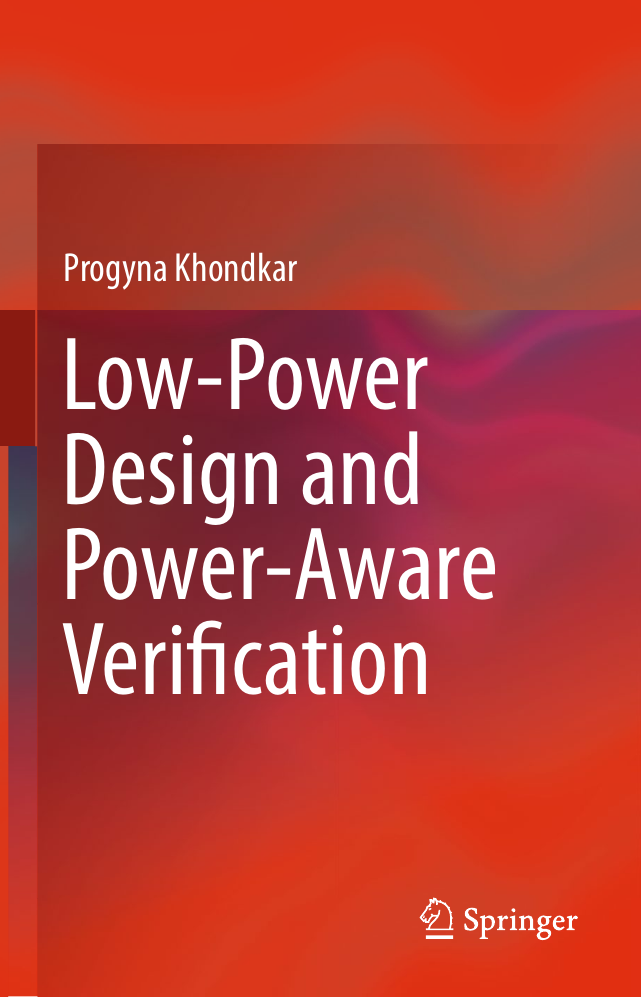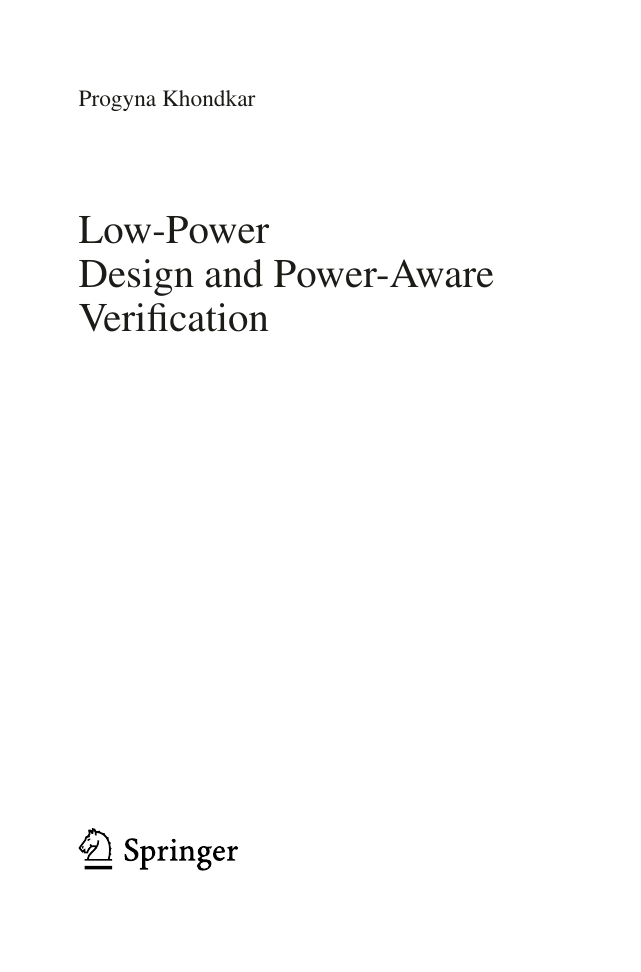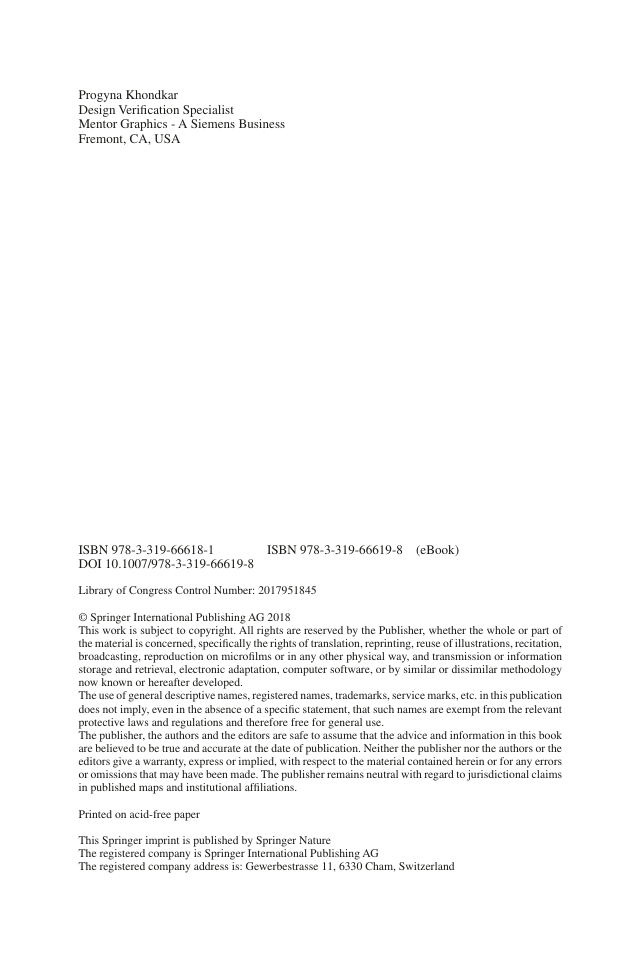Dedication
Preface
Acknowledgement
Contents
Author Bios
Chapter 1: Introduction
Chapter 2: Background
2.1 The Power Intent
2.2 The Abstraction of UPF
Chapter 3: Modeling UPF
3.1 Fundamental Constructs of UPF
3.1.1 UPF Power Domain and Domain Boundary
3.1.2 UPF Power Supply and Supply Networks
3.1.3 UPF Power States
3.1.4 UPF Power Strategies
3.2 Successively Refinable UPF
3.3 Incrementally Refinable UPF
3.4 Hierarchical UPF
Chapter 4: Power Aware Standardization of Library
4.1 Liberty Power Management Attributes
4.2 Power Aware Verification Model Libraries
4.2.1 Non-PA Simulation Model Library
4.2.2 PA-Simulation Model Library
4.2.3 Extended-PA-Simulation Model Library
Chapter 5: UPF Based Power Aware Dynamic Simulation
5.1 PA Dynamic Verification Techniques
5.2 PA Dynamic Simulation: Fundamentals
5.3 PA Dynamic Simulation: Verification Features
5.4 PA Dynamic Simulation: Verification Practices
5.5 PA Dynamic Simulation: Library Processing
5.6 PA Dynamic Simulation: Testbench Requirements
5.7 PA Dynamic Simulation: Custom PA Checkers and Monitors
5.8 PA Dynamic Simulation: Post-Synthesis Gate-Level Simulation
5.9 PA Dynamic Simulation: Simulation Results and Debugging Techniques
Chapter 6: Power Aware Dynamic Simulation Coverage
6.1 PA Dynamic Simulation: Coverage Fundamentals
6.2 PA Dynamic Simulation: Coverage Features
6.3 PA Dynamic Simulation: Coverage Practices
6.3.1 Coverage Computation Model: For PA Dynamic Checks
6.3.2 Coverage Computation Model: For Power States and Power State Transitions
6.3.3 Autotestplan Generation: From PA Dynamic Checks and Power State Transitions
6.3.4 Coverage Computation Model: For Cross-Coverage
Chapter 7: UPF Based Power Aware Static Verification
7.1 PA Static Checks: Fundamental Techniques
7.2 PA Static Checks: Verification Features
7.3 PA Static Checks: Library Processing
7.4 PA Static Checks: Verification Practices
7.5 PA Static Checks: Static Checker Results and Debugging Techniques
Bibliography
学霸图书馆
link:学霸图书馆
















 2023年江西萍乡中考道德与法治真题及答案.doc
2023年江西萍乡中考道德与法治真题及答案.doc 2012年重庆南川中考生物真题及答案.doc
2012年重庆南川中考生物真题及答案.doc 2013年江西师范大学地理学综合及文艺理论基础考研真题.doc
2013年江西师范大学地理学综合及文艺理论基础考研真题.doc 2020年四川甘孜小升初语文真题及答案I卷.doc
2020年四川甘孜小升初语文真题及答案I卷.doc 2020年注册岩土工程师专业基础考试真题及答案.doc
2020年注册岩土工程师专业基础考试真题及答案.doc 2023-2024学年福建省厦门市九年级上学期数学月考试题及答案.doc
2023-2024学年福建省厦门市九年级上学期数学月考试题及答案.doc 2021-2022学年辽宁省沈阳市大东区九年级上学期语文期末试题及答案.doc
2021-2022学年辽宁省沈阳市大东区九年级上学期语文期末试题及答案.doc 2022-2023学年北京东城区初三第一学期物理期末试卷及答案.doc
2022-2023学年北京东城区初三第一学期物理期末试卷及答案.doc 2018上半年江西教师资格初中地理学科知识与教学能力真题及答案.doc
2018上半年江西教师资格初中地理学科知识与教学能力真题及答案.doc 2012年河北国家公务员申论考试真题及答案-省级.doc
2012年河北国家公务员申论考试真题及答案-省级.doc 2020-2021学年江苏省扬州市江都区邵樊片九年级上学期数学第一次质量检测试题及答案.doc
2020-2021学年江苏省扬州市江都区邵樊片九年级上学期数学第一次质量检测试题及答案.doc 2022下半年黑龙江教师资格证中学综合素质真题及答案.doc
2022下半年黑龙江教师资格证中学综合素质真题及答案.doc